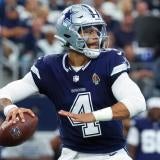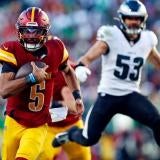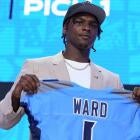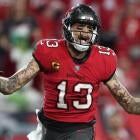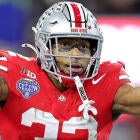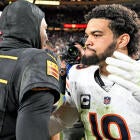Check out a breakdown of each position in 2017 here: Quarterbacks – Running Backs – Wide Receivers – Tight Ends
You've heard the phrase, "It's a passing league," right?
Well, not like it used to be.
Two short years ago, the top-12 receivers averaged a hefty 12.2 Fantasy points per game. No. 2 guys averaged nearly nine points per game, while No. 3 wideouts came through for 7.4.
Those averages have dipped quite a bit since – the top-12 pass-catchers slid to 9.96 Fantasy points per game in non-PPR, while those ranked 13 through 24 delivered 7.9 points on average and the No. 3 options dipped to a tight end-esque 6.5 Fantasy points per matchup.
It gets worse: The difference between the No. 13 receiver in 2017, Doug Baldwin, and the No. 36 receiver, Ted Ginn, was just 44 points, roughly 2.8 points per game. So the best of the No. 2 receivers was only slightly better than the worst of the No. 3 receivers. That's less than point differential between Baldwin and No. 1 receiver DeAndre Hopkins, 4.1 per game.
But perhaps the most frustrating part about receivers in 2017 was the lack of consistently good players. Only four receivers – Hopkins, Antonio Brown, Davante Adams and Odell Beckham – reached 10-plus Fantasy points in at least half of their games. That's it. I wish I was kidding. By comparison, 14 receivers got to the 50-percent mark in 2016.
All of this happened because passing declined in 2017. Pass attempts were down to their lowest numbers since 2011 (17,475 attempts), and so were receptions by wide receivers (5,825). Subsequently, receiving yards (75,034) and touchdown catches (437) were both down to levels not seen since 2009. So not only did receivers not have as many chances to catch as many passes as in the last several years, but they did less with what they did catch. It did not help that only 16 receivers averaged more than eight targets per game – and three of them played in eight games or fewer.
| Player | GP | TGTS/gm | FPTS/gm | Consistency |
| DeAndre Hopkins | 15 | 11.7 | 13.8 | 73.3% |
| Antonio Brown | 14 | 11.6 | 14.6 | 64.3% |
| Odell Beckham | 4 | 10.3 | 11.5 | 50.0% |
| Larry Fitzgerald | 16 | 10.1 | 9.1 | 37.5% |
| Jarvis Landry | 16 | 10.0 | 8.9 | 43.8% |
| Keenan Allen | 16 | 9.9 | 10.6 | 43.8% |
| Julio Jones | 16 | 9.3 | 9.8 | 31.3% |
| Michael Thomas | 16 | 9.3 | 9.2 | 37.5% |
| A.J. Green | 16 | 9.0 | 9.1 | 37.5% |
| Mike Evans | 15 | 9.0 | 8.3 | 40.0% |
| Adam Thielen | 16 | 8.9 | 8.8 | 31.3% |
| Demaryius Thomas | 16 | 8.8 | 7.2 | 37.5% |
| Josh Gordon | 5 | 8.6 | 7.2 | 40.0% |
| Davante Adams | 14 | 8.4 | 10.2 | 57.1% |
| Pierre Garcon | 8 | 8.4 | 5.8 | 12.5% |
| Dez Bryant | 16 | 8.3 | 6.9 | 31.3% |
If you want to download the full chart, go to this Google Doc spreadsheet and click "File + Download."
And here is how every wide receiver who scored at least 100 points fared when looking at Fantasy points per game as well as consistency. The size of the bubble represents their total Fantasy points for the season (scroll over for more details):
Unfortunately, this is a Fantasy Football problem, not an NFL problem.
Many teams have evolved to incorporate spread-style concepts into their schemes and using multiple receivers, tight ends and particularly running backs as pass catchers more than ever. Running backs also took more handoffs in 2017 than they have in any of the three years prior. They're poaching opportunities away from receivers, and it's not guaranteed to change – just as there are plenty of great quarterbacks all over the league, so too are the number of great rushers. Young receivers typically don't develop at the same rate.
Knowing what we know, there are three in-draft strategies to consider heading into 2018.
- After the top tier studs are gone, hone in on the "boom or bust" guys: If consistency is going to be a problem with the overwhelming majority of receivers taken on Draft Day, you might as well hone in on the ones who will deliver some massive eruptions. We're talking about guys like Brandin Cooks, Doug Baldwin, Amari Cooper, T.Y. Hilton, Marvin Jones and Stefon Diggs – players who might stink up the joint for 30 yards one week, then score twice and top 100 yards the next. You'd rather have an inconsistent receiver with huge potential than one who can't get you more than 12 Fantasy points even in his good weeks.
- Chase receivers with young quarterbacks and/or fresh playcallers: San Francisco. Houston. Kansas City. Chicago. Potentially Arizona and the New York Jets, too. Creative thinking leads to offenses putting up some big numbers, and where there are big numbers, there are Fantasy heroes. Of course the well-known wideouts will get taken first, but there will be breakout candidates at bargain values on teams charting into new territories.
- Stream receivers: This is a jarring idea, but it's one I quietly floated last year and will consider for my squads in 2018. In theory, an owner would draft one stud receiver early and then fill every other position before collecting four more receivers to rotate in and out of his lineup. You won't have a studly receiving corps, but what good would that have done you in 2017? Besides, going this route would open the door to have a studly running back corps, which wouldn't be a bad thing.
Bottom line: Fantasy point production among receivers declined, but it's not promised to stay that way. It's also not promised to rebound to where we were in 2015. We'll get Beckham back and hopefully household names like Julio Jones, A.J. Green and Mike Evans rebound. You can be sure that Round 2 will be full of capable No. 1 receivers you'll confidently start, but past that, you'll want to strategize on how you'll attack the receiver position in your leagues.
![[object Object] Logo](https://sportshub.cbsistatic.com/i/2020/04/22/e9ceb731-8b3f-4c60-98fe-090ab66a2997/screen-shot-2020-04-22-at-11-04-56-am.png)

